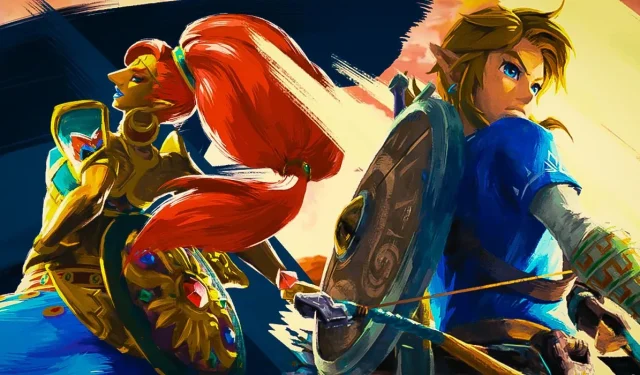
The Gerudo language represents a captivating component of the worldbuilding within The Legend of Zelda, particularly in the titles *Breath of the Wild* and *Tears of the Kingdom*. This constructed language adds remarkable depth to the immersive experience of Hyrule’s expansive landscape. While *Tears of the Kingdom* has made some strides in elaborating on this linguistic element, it falls short of fully realizing its potential.
Among the various races populating *The Legend of Zelda*, the Gerudo hold a particularly vital position. They are featured prominently in *Breath of the Wild*, *Tears of the Kingdom*, and more recently, *Echoes of Wisdom*. Notably, Ganondorf, the series’ famed antagonist, is also a Gerudo, marking him as the only recognized male of this primarily female race. Characterized by their formidable physical abilities, the cultural identity of the Gerudo draws parallels to the Amazons of Greek mythology.
The Gerudo’s Spoken Language: A Remarkable Feature
The Intricacies of Fictional Languages



One of the most fascinating aspects of worldbuilding is the inclusion of conlangs—constructed languages that enrich the narrative fabric of fictional realms. The Gerudo language is a striking example of this, woven throughout *Breath of the Wild* and *Tears of the Kingdom* as a focal point of Gerudo culture. Non-playable characters (NPCs) frequently greet players in Gerudo, and leverage an assortment of terms within this unique lexicon. Although the vocabulary is limited, its presence within the Gerudo community creates an illusion of a more extensive linguistic framework.
Experiencing a fictional language firsthand during gameplay is exhilarating. This dynamic lends authenticity to Gerudo culture, setting it apart from the broader realm of Hyrule, especially because the Gerudo’s native tongue is not shared with other regions. Historically, the desert-dwelling Gerudo had conflicts with Hyrule under Ganondorf’s reign, contributing to their distinct cultural and linguistic identity.
It’s also notable that the written form of the Gerudo language predates its spoken counterpart and follows distinct patterns. Mirroring other alphabets in *The Legend of Zelda*, the Gerudo alphabet can be transcribed into the Latin alphabet, functioning as a substitution cipher with direct English translations. However, this raises linguistic challenges, as it implies the amalgamation of English words with the Gerudo language, which complicates their distinctly different pronunciations.
The Case for Expanding the Gerudo Language
A Limited Gerudo Vocabulary

One aspect I find lacking in the portrayal of the Gerudo language within *Breath of the Wild* and *Tears of the Kingdom* is the limited scope of its usage. While *Tears of the Kingdom* introduced some shortened slang variations, the opportunity to expand this vocabulary significantly remains largely untapped. Enhancing the Gerudo lexicon would not only allow for deeper language engagement but also enrich the representation of Gerudo culture, especially if it included idioms and cultural expressions.
I understand the rationale for the current brevity of the Gerudo language in the series. Although it features prominently during interactions with certain characters, it remains a relatively small facet of the greater narratives at play. This succinctness helps maintain focus on the broader gameplay, allowing just enough linguistic diversity to intrigue players without overwhelming the experience. Nevertheless, there are numerous avenues through which the Gerudo language could be further developed in the future.
Opportunities for expansion abound. A straightforward approach would be to feature the Gerudo more prominently in the next installment of *The Legend of Zelda*, naturally integrating new vocabulary through character interactions. Just as previous titles introduced and familiarized Link with their language, new entries could continue this tradition. Additionally, a supplementary book could serve as a comprehensive resource to expand the Gerudo lexicon, offering deeper insight than what might be achievable through gameplay alone.
Creating New Gerudo Words: A Simple Challenge
Roots in Real-Life Language

Interestingly, many Gerudo words appear to have origins in Japanese, or Japanese adaptations of English loanwords, although the meanings may diverge significantly from their in-game usage. For instance, the term “Sav’otta”seems to derive from “Sabotta,”referring to a state of idleness. Moreover, many of these roots are thematically related to deserts, with the exclamation “Sa’oten,”stemming from “Saboten,”meaning “cactus.”This connection opens a wellspring of possibilities for crafting new Gerudo words, either by enhancing existing themes or exploring similarly phonetic terms.
The distinctive substitution of “b”sounds with “v”reflects the nuances of Japanese pronunciation, where these variants can often be perceived as interchangeable. This phonetic nuance further enriches the language’s character within the fictional context.
Delving into the Gerudo language offers gamers a unique pathway to engage with the rich cultural fabric of one of Zelda’s fascinating races. Currently, the brevity of the vocabulary poses a limitation; however, I am hopeful that The Legend of Zelda will introduce more characters who utilize their native tongue in substantive ways. As intriguing as the Gerudo language is, it remains relatively underdeveloped, waiting to be further explored in future iterations of the series.




Leave a Reply ▼